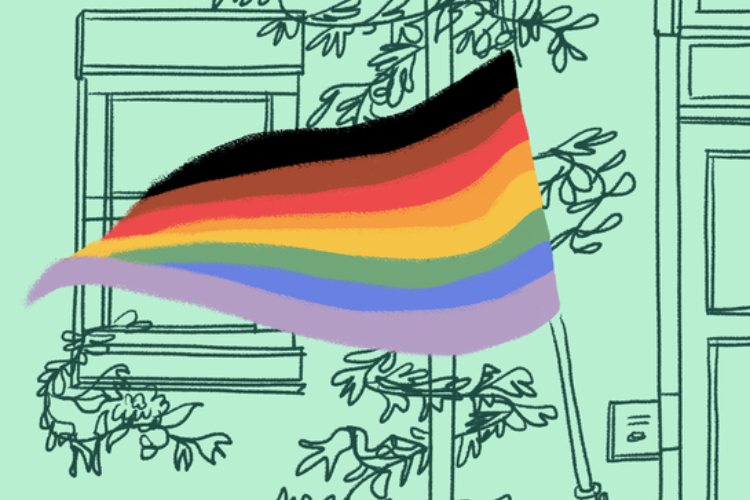
An image of the LGBTQ+ pride flag. Illustrated by Hannah Minn. Photo Credit: Refinery 29
It is necessary to focus on intersectionality, sexuality awareness, and open discussions in LGBTQ+ safe spaces.
When it comes to marginalized groups, it has become increasingly important to focus on intersectionality, specifically inside LGBTQ+ spaces that are present in schools. Intersectionality is the need for overlap between independent systems of discrimination and disadvantage. In today’s world, intersectionality has been coined as a “buzzword.” During the past decade, there have been big strides made by education systems to become more inclusive of LGBTQ+ students and create safe spaces for them. But what truly defines a safe space, and how can misconceptions inside them end up creating even less awareness?
In 2019, 11.7% of students from 15 years old to 17 years old identified as “non-heterosexual,” according to the CDC. By comparing this percentage to that of 2015 (8.9%), it is clear that throughout the next few years this number will continue to rise. Though the number of LGBTQ+ students is rising, awareness and acceptance of different identities and sexualities are at a slow crawl, even inside the community. A student from Thomas Jefferson High School (TJ) agreed to do an anonymous interview about their experience as a bisexual person within TJ’s GSA club. They stated that “inside the club, my sexuality was seen as invalid or as some attention grab from some of the other students.” Though this may sound surprising, there is a large amount of biphobia inside the community today.
According to an interview done by the BBC of Ruth Hunt, the head of the Stonewall charity, “We know from all our evidence that bi people really do worry about the hostility they experience from our own communities.” In that same interview, the charity’s research suggested that “27% of bi women and 18% of bi men have experienced biphobia from within the LGBT community.” The type of misconceptions that are rooted in biphobia, such as a bi person is just on their way to be gay or are just experimenting, end up seriously harming bisexual people. As another bisexual TJ student, Shana Saint-Phard, stated, “I’ve been dealing with the kind of conceptions of you’re confused, like you’re either gay or straight, and I really internalized those for such a long time.” Because of this, it is critical for TJ’s safe spaces to be open and accepting of all queer individuals.
Though it is popularized for queer people to participate in queer discourse in LGBTQ+ safe spaces, it is important to note how queer discourse can invalidate an identity. Some queer discourse topics are highly beneficial to the community, like the legal rights of transgender students and violence against LGBTQ+ people. However, when it comes to queer definitions, Saint-Phard states, “I wouldn’t discuss it like the actual validity of people’s sexualities because that it hurts the people whose identity is being called into question.” Sharing opinions and experiences is extremely important to achieve intersectionality; however, there must be a line drawn between open discussions and attacking another person’s identification.
Accepting bisexual people is just the tip of the iceberg when it comes to intersectionality. Intersectionality is a beautiful way to bring students together; as said by Saint-Phard, “[a club] requires all genders and race representation because each little bubble of identity when they come into contact with each other they create something completely different.” Each LGBTQ+ individual has their own gender, race, nationality, religion, and background; because of this, different types of discrimination and stereotypes affect each person. For example, a black queer woman will face a different type of homophobia, sexism, and racism than a black queer man. Because of this, it is extremely important for every student at any school level to understand identities, the discrimination they may face, and accept people who are different from themselves. In order to do this, clubs like GSA and high schools need to focus on reaching out to the full student body. This type of outreach can be as simple as a school implementing a program to have an annual check-in with students to ensure that the correct pronouns are used for them and their preferred name. It can also be requiring preferred pronouns inside introduction presentations at the beginning of the year. By doing this, transgender students do not have to have possibly uncomfortable conversations with teachers and other students. These types of policies have already been implemented at the university and college level, but in order to support trans students, they need to be implemented in earlier school stages.
How intersectionality can be brought into any safe space is an important discussion in any environment, inside and outside of school. TJ is already taking these strides and is very open to these types of policy changes. Within the Denver Public School District there is also a great amount of support shown to queer and trans students, i.e. the DPS statement of support (DPS Statement of Support for LGBTQ+ Students) and the January 23rd Board Resolution (Board Resolution). Due to this, the future at TJ for LGBTQ+ students looks brighter. A school is a place for education and this includes education that needs to occur for a student body to become welcoming of others.